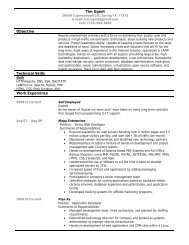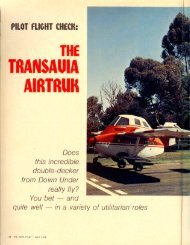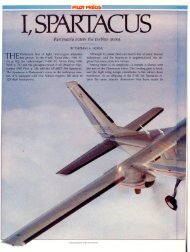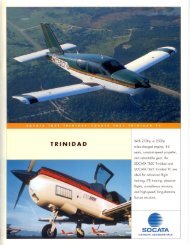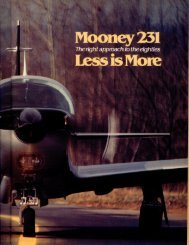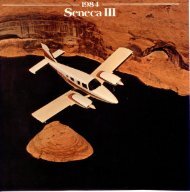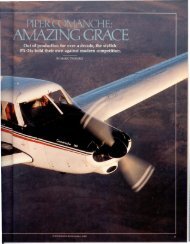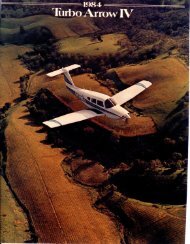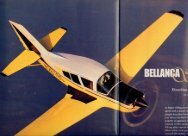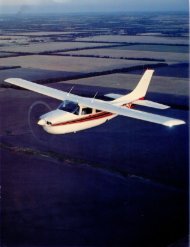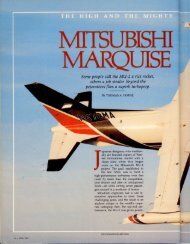A Merlin by any other name - Aero Resources Inc
A Merlin by any other name - Aero Resources Inc
A Merlin by any other name - Aero Resources Inc
- No tags were found...
You also want an ePaper? Increase the reach of your titles
YUMPU automatically turns print PDFs into web optimized ePapers that Google loves.
the APS-80T autopilot.When certification is completed, theaircraft equipped price will be$2,409,670, including $36,000 in interiorand airframe options (it is fittedwith a continuous alchohol/water injectionsystem to improve runway andweight performance during hot andhigh conditions). Avionics options total$403,660.The 300 created quite a stir when itarrived at the ramp in Frederick, Maryland.It was flown <strong>by</strong> James R. Milner,who is a Fairchild engineering test pilot,accompanied <strong>by</strong> Phil Van Ostrand,a former AOPA employee and AOPAPilot staff member who now works forFairchild.People tend to think of it as the little<strong>Merlin</strong> because of its longer br<strong>other</strong>,the <strong>Merlin</strong> IV/Metro, which is currentlyundergoing a transformation tothe Fairchild 400. However, it is a bigairplane that can carry two cre}\' plusup to eight passengers. The cabin isnormally configured for six. Excludingthe cockpit, it is just under 17 and ahalf feet long and more than five feetwide.Typical of this category of aircraft, itwas fitted with a full set of amenities,from a Wulfsberg Flitefone, refreshmentcenter and cabinetry to a lavatorycomplete with flushing biffy.There is a large baggage compartmentaft (and there is a nose baggage bayoutside of the pressure vessel).The cockpit is high (both in headroomand distance above the ramp),wide and handsome. A distinctive featureof the 300 is the three-panel windshield.The left and right panels areelectrically heated glass. Organizationof instruments, controls and systems isgood; while the 300 is a highly complexaircraft, learning your way aboutthe cockpit is simple.Speaking of learning, Fairchild offerscrew and maintenance trainingthrough FlightSafety International at afacility co-located with the factory inSan Antonio, Texas. Initial and recurrenttraining should be consideredmandatory <strong>by</strong> <strong>any</strong> operator.Milner took a few of us on a walkaround inspection before flight thatwas a typical thorough, first flight ofthe day check. He pointed out some ofthe features that distinguish the 300,including the new shape of the trailingedge of the aileron. Access to all thepoints that need a going over, includingdropping the gear doors to checkinside the wells, is good.Start and operation of the 900 shafthorsepower (shp) Garrett TPE331-IOU503G engines is simplified <strong>by</strong> automaticstart sequencing, fuel controland Single Red Line (SRL) computers.The SRL computer senses temperaturefrom several sources, computes thecombined value against engine temperaturelimits and works to limit pilotinput from creating an overtemperaturecondition-and the attendant expense.A negative torque sensing system(NTS) is an<strong>other</strong> feature of thepowerplant. It senses differentialtorque between the engines and automaticallymoves the propeller on theaffected engine toward feather in theevent of power failure. Coupled withthe rudder boost system that automaticallyinputs yaw force toward the operatingengine, it greatly aids aircraftcontrol in the event of engine failure. Itis a no-go item.When all works as it is designed to,crew workload from start to stop islow. You are more a monitor of automatedprocesses than a link in thechain of operations.The equipped empty weight ofN447SA is 8,350 pounds. Rampweight at start, with four on board and2,000 pounds of fuel, was well belowmaximum for FAR 23 operation at approximately11,200 pounds, and 2,130pounds below the SFAR 411irnit.Milner took some time to brief meon the hydraulically actuated nosewheelsteering system before enginestart, since there are two levels of authority,one used for maneuvering intight spaces that permits greater degreeof nosewheel deflection, and the<strong>other</strong> for normal taxiing and takeoff.Steering is operated through the rudderpedals; the high authority mode isselected <strong>by</strong> actuation of a switch onthe pilot's side panel, the normalmode through a switch on the left enginecondition lever. With a little practice,ground handling is easy. The systempermits taxiing on one engine.A stability augmentation system(SAS), including an angle of attack indicatorand stick pusher, is part of thebasic equipment. It increases stickforces at low airspeed, nominally below135 KIAS, to artificially eliminatepitch sensitivity.The check list is long, as you wouldexpect for an aircraft of this type. SinceI had not flown a <strong>Merlin</strong> of <strong>any</strong> sortfor quite a while, it took a bit of time toperform the checks and get to the departureend of the runway. However,there is nothing remarkable about theprocedures or sequence.Our calculated rotation speed for theAOPA PILOT • 69



